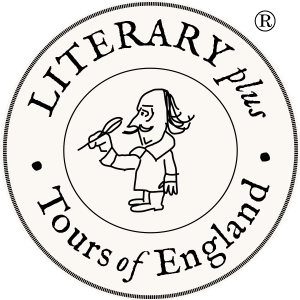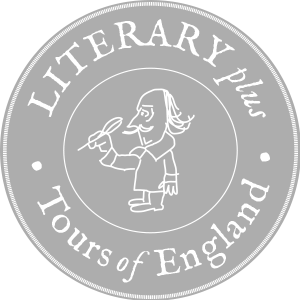
This specially designed tour takes you to the historic city of Bath, where the Austen family lived for six years, and to their home in Hampshire. The tour is completely private. You and your party will be our only guests. What’s more, the pace is unhurried. You’ll have plenty of time to immerse yourself in Jane Austen’s world and enjoy every site you visit (literary, non-literary, film and TV locations).
The Jane Austen Tour has been thoughtfully designed by the experts at Literary Tours of England. However, we’re flexible: the tour can be modified to reflect your personal tastes and preferences. The itinerary can even be adjusted en route to take account of weather conditions, local events, etc. If you wish, your tour can be extended to include London and/or other areas of England.
The tour includes:
- Met by guide at LHR
- Personal guide/driver
- Comfortable vehicle
- 4-star luxury hotels
- Breakfast every day
- Expert city guides
- Site/attraction entrance fees
- Tips, service charges, etc
- 24/7 local support
For lunch, afternoon tea and dinner (per your preference) your tour guide will help you find the type of eating establishment and food you like, from country pub to fine cuisine.
Day 1: Drive to Bath
You are met at London’s Heathrow Airport by your personal driver / tour guide. The relaxing drive to Bath takes approximately two hours. Your four-star hotel is right in the city center, within walking distance of all amenities.
Day 2: Explore Bath
A full day to enjoy this historic city and its Jane Austen associations.
Bath is a special place. Built by the Romans around the only natural hot springs in England, it’s been preserved for its marvelous Roman remains and its Georgian architecture in the Palladian style. No wonder the entire city has been designated a World Heritage Site by UNESCO. Jane Austen lived in Bath – unhappily – from 1801 to 1806 and the city, especially its social life, provided inspiration for her novels. Northanger Abbey (1817) and Persuasion (1818) are even set in Bath. We’ll visit the Jane Austen Centre, a modest museum that commemorates Jane’s time in the city. You’ll be greeted on the front steps by Mr Bennet from Pride and Prejudice (1813). Actually it’s Martin Salter, who’s said to be the most photographed man in England! The museum features an instructive video presentation and costumed guides. There’s also a fine gift shop and Regency Tea Room. Bath has been used as a location for many feature films and TV shows, including the BBC’s excellent adaptation of Persuasion (2007), starring Sally Hawkins.
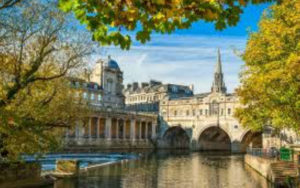
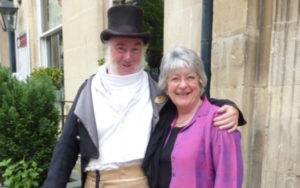
Day 3: Explore Bath
Another full day to enjoy this lovely city and its Jane Austen associations.
The Roman Baths are spectacular. You’ll wander through the impressive ruins and marvel at how they have been so carefully preserved. The experience is enhanced by interactive displays illustrating how Bath’s natural hot springs have been attracting visitors for thousands of years. Nowhere else in the Roman Empire has such a large collection of baths, treatment rooms and shrines been discovered. Excavations suggest there was human activity around the spring as long as 8,000 years ago. This will all come to vivid life as you listen to the informative and entertaining commentary by the inimitable Bill Bryson through the freely available audio guides. From the entrance to the Roman Baths, in the Abbey Churchyard, there’s a marvelous view of the west front of Bath Abbey. A free audio walking tour, In the Footsteps of Jane Austen, begins here and includes most of the city’s principal sites. We’ll linger at No. 1 Royal Crescent (now a museum), The Circus (a unique blend of classical Roman and British pagan influences) and Pulteney Bridge, built in 1773 and lined with shops. Speaking of which, Bath offers some of England’s best shopping outside London.
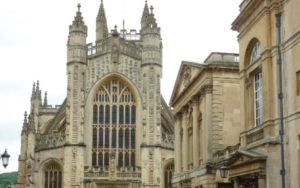
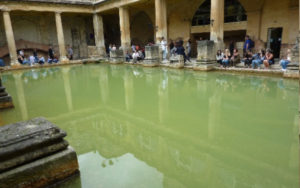
Day 4: Drive to Winchester
Visit the preserved village of Lacock and other sites along the way.
A 30-minute drive east from Bath brings us to the preserved village of Lacock and its Abbey, instantly recognizable as a location for countless period dramas in film and television, notably the memorable BBC television adaptation of Pride and Prejudice (1995) starring Colin Firth and Jennifer Ehle. Others include Cranford (2007), The Other Boleyn Girl (2008), Henry V (2012), several Harry Potter films (2001-11) and Downton Abbey (2019). Lacock Abbey is actually a rather quirky country house, owned by the National Trust, now housing a museum dedicated to William Henry Fox Talbot, its former resident, the father of British photography. From Lacock a 90-minute cross-country drive brings us to King Alfred the Great’s 9th Century capital, Winchester, a charming city criss-crossed by ancient streets and dominated by one of the largest Gothic cathedrals in Europe. Jane Austen is buried there, as also is Izaak Walton, author of The Compleat Angler (1653). Your four-star hotel is right in the city center, within walking distance of all amenities.
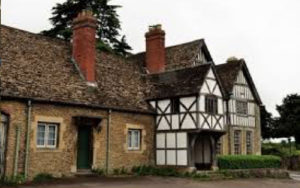
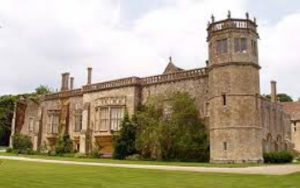
Day 5: Explore Jane Austen’s Hampshire
A full day to enjoy Jane Austen’s House Museum and associated sites.
We’ll first visit the village of Steventon, where Jane’s father was the parish rector. She was born in Steventon in 1775 and spent much of her early life there. Following numerous moves around southern England, notably Bath (1801-06), the family returned to Hampshire. In 1809 they settled in Chawton, described by Jane as “a remarkably pretty village”. Their home is now the Jane Austen’s House Museum and it’s there that Jane spent the last eight years of her short life. Inside the museum you’ll quickly become immersed in Jane’s world, especially when you imagine her sitting at the little three-legged table she used as a writing desk. Not many other authentic pieces have survived, but numerous family portraits and possessions have been arranged to illustrate the late 18th and early 19th Century life of the Austen family. Jane was much happier in rural Chawton than she had been in the big city of Bath. That’s probably why these final years were especially productive. She edited Sense and Sensibility (1811) and Pride and Prejudice (1813) prior to their publication. Then she wrote Mansfield Park (1814), Emma (1816) and Persuasion (1818). She even started another novel, Sanditon, but managed to complete only eleven chapters. The unfinished work, published in 1925, was rather controversially completed and adapted by Andrew Davies for BBC television (2019).
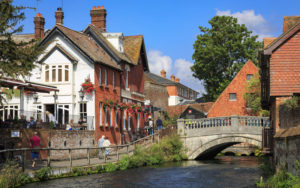
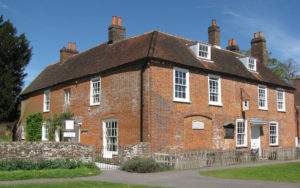
Day 6: Explore Winchester and other attractions
A full day to enjoy this historic city and your choice of nearby sites.
In addition to Winchester’s splendid cathedral, you might like to visit The Great Hall, all that remains of Winchester Castle, which contains King Arthur’s legendary Round Table. There’s also Winchester City Mill, more than a thousand years old and probably the oldest working watermill in the UK. The city also offers fine shopping. Then you might want to visit Highclere Castle, only a 30-minute drive away. Better known as Downton Abbey in the TV series (2010-15) and feature film (2019) this stately country house, set in a park designed by Capability Brown, is the home of the Earl and Countess of Carnarvon. Alternatively, Portsmouth is only a 45-minute drive from Winchester. Home of the Royal Navy, the city is steeped in maritime history from Tudor times to D-Day. Charles Dickens was born there in 1812 and the modest family home is now the Charles Dickens Birthplace Museum. Arthur Conan Doyle moved to Portsmouth as a young doctor in 1882 and it was there that he wrote A Study in Scarlet (1887) which introduced the world to Sherlock Holmes. The Portsmouth City Museum houses collections dedicated to both Dickens and Doyle. Stonehenge is also a 45-minute drive from Winchester. This world-famous marvel comprises a ring of standing stones, each around 13 feet high and weighing around 25 tons: a masterpiece of engineering that dates from 3000 BC to 2000 BC.
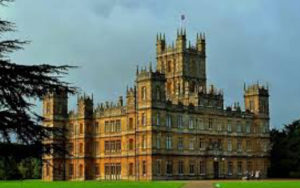
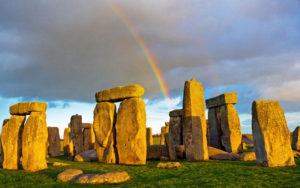
Day 7: Drive to Heathrow Airport
The easy return journey to London’s Heathrow Airport takes only an hour. We’ll stop at significant sites along the way if time permits.
